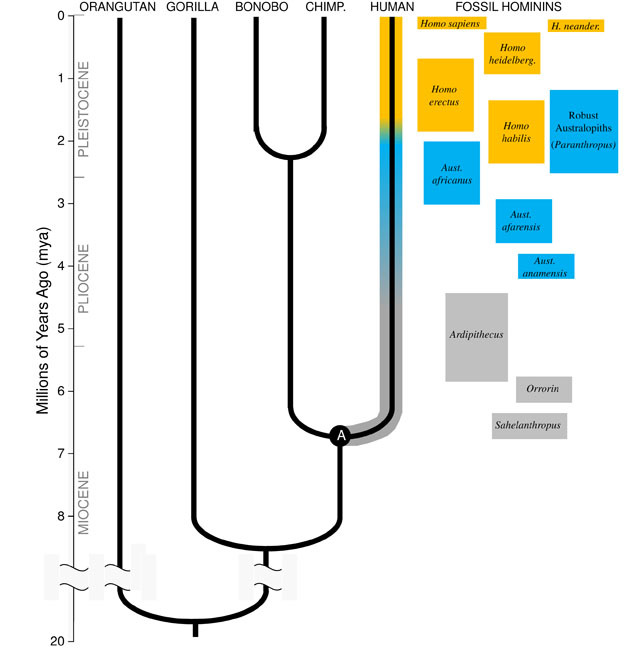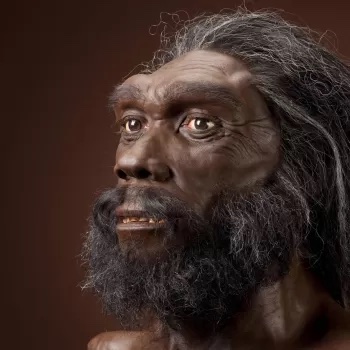I was inspired by our class discussion last week about a species hierarchy. Most groups, including my own, placed humans above all other species. But this sparked the question; at what point in our evolution did we become a species deserving of this ranking? Is this top spot reserved solely for Homo Sapiens? Or the more general genus of Homo? Was Homo Erectus or Neanderthals advanced enough to occupy this top spot? What about the pre-humans that built the 476,000 year old wooden structure recently discovered? No other animals seem to be capable of such a feat. So, what is the line between human and animal, and when did our evolution surpass that line?

The earliest fossils from the genus Homo were discovered in east Africa and dated back 2.3 million years. We know that members of the genus homo used simple stone tools to butcher animal carcasses around 1.8 mya, which elevated their mainly plant diet (Pontzer, 2012). This seems like a definingly Homo trait, yet many animals use stones as tools, including chimpanzees, monkeys, otters, birds, and some fish (Bressan, 2019). However, it seems as if the genus Homo is the only one to have the capacity to modify these stones before use. Maybe the capacity to manufacture tools is what separated the genus Homo from every other.
Homo Erectus evolved 1.9 million years ago, and persisted until only about 100 thousand years ago. By this time, they occupied Africa and Eurasia, meaning the species had adapted to living in a wide range of environments. The species’ brain size had drastically increased, containing the cognitive capacity to adapt and thrive in any climate (Pontzer, 2012). Perhaps this was the cognitive advancement that set us apart from the rest of the animal kingdom. We also know Homo Erectus and other hominins of the time used wooden tools, though not many survive. The oldest discovered wood artifact is a polished wood plank found in Israel, dating over 780 thousand years old.
Then, about 700,000 years ago, Homo Erectus had evolved into Homo Heidelbergensis, who had much in common with modern humans, including bodily proportions, dental adaptations, and cognitive abilities. Homo Heidelbergenis used Levallois style tools and had mastered control of fire. Archaeologists have also found 400,000 year old wood tools used for foraging and hunting. It was likely this species that constructed the 480,000 year old wooden structure, likely a platform used for fishing (Sulivan, 2023). Neanderthals evolved from Homo Heidelbergensis by 250 thousand years ago, and about 50,000 years following, our own species, Homo Sapien, evolved from Homo Heidelbergensis in Africa. Eventually, Homo Sapiens had spread throughout Eurasia, the Americas, and Australia (Pontzer, 2o12).


The point at which the genus Homo claimed its lead in the species hierarchy depends on what Homo-specific advancement you consider to define that jump. Homo Erectus’ ability to thrive in any environment seems the most convincing to me, as this demonstrates a mastery of nature not seen in any other species.
Further Reading:
https://www.scientificamerican.com/article/2-mental-abilities-separate-humans-from-animals/
Works Cited:
Bressan, D. (2019, March 18). Archaeological evidence shows how animals are mastering the use of Stone Tools. Forbes. https://www.forbes.com/sites/davidbressan/2019/03/16/the-animals-that-have-entered-the-stone-age/?sh=1337f9c5b4cd
Pontzer, Herman. (2012) Overview of Hominin Evolution. Nature Education Knowledge https://www.nature.com/scitable/knowledge/library/overview-of-hominin-evolution-89010983/
Sulivan, William. (2023, September 22). Archaeologists uncover notched logs that may be the oldest known wooden structure. Smithsonian.com. https://www.smithsonianmag.com/smart-news/archaeologists-uncover-notched-logs-that-may-be-the-oldest-known-wooden-structure-180982942/#:~:text=Archaeologists%20have%20uncovered%20evidence%20of,date%20to%20476%2C000%20years%20ago.

You mention “dental adaptations” — what is the significance of dental studies in tracing the past of Homo sapiens? What do they tell us about ancient humans?
Dental studies provide a window into a variety of details about ancient humans. First of all, the shape of teeth can be used to identify a subject’s gender and race. The condition of teeth can be used to assess diet. Studying the plaque on ancient teeth can reveal more about diet and even how medical conditions were treated, based on what medicinal DNA remnants remain. The nerve inside of a tooth is also very well preserved and can be used to study genetics, even when the rest of the body is badly damaged.
(2018, September 26) What Ancient Teeth Can Tell Us About Humanity’s Past. UIC College of Dentistry. https://dentistry.uic.edu/news-stories/what-ancient-teeth-can-tell-us-about-humanitys-past/